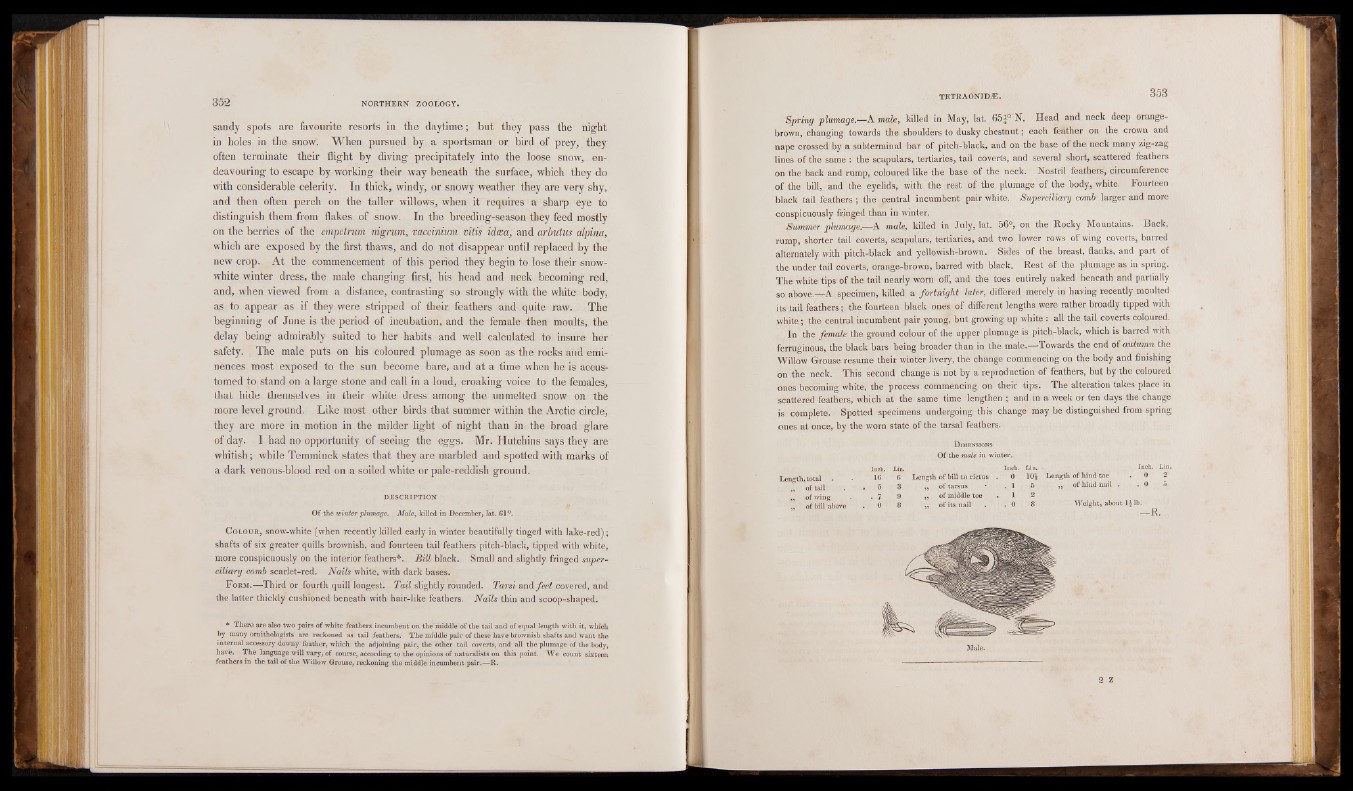
sandy spots are favourite resorts in the daytime; but they pass the night
in holes in the snow. When pursued by. a sportsman or bird of prey, they
often terminate their flight by diving precipitately into the loose snow, endeavouring
to escape by working their way beneath the surface, which they do
with considerable celerity. In thick, windy, or snowy weather they are very shy,
and then often perch on the taller willows, when it requires a sharp eye to
distinguish them from flakes of snow. In the breeding-season they feed mostly
on the berries of the empetrum nigrum, vaccinium viti-s idcea, and arbutus alpina,
which are exposed by the first thaws, and do not disappear until replaced by the
new crop. At the commencement of this period they begin to lose their snow-
white winter dress, the male changing first, his head and neck becoming red,
and, when viewed from a distance, contrasting so strongly with the white body,
as to appear as if they were stripped of their, feathers and quite raw. The
beginning of Juneas the period of incubation, and the female then moults, the
delay being admirably suited to her habits and well calculated to insure her
safety. The male puts on his coloured plumage as soon as the rocks and eminences
most exposed to the sun become bare, and at a time when he is accustomed
to stand on a large stone and call in a loud, croaking voice to the females,
that hide themselves in their white dress among the unmelted snow on the
more level ground. Like most other birds that summer within the Arctic circle,
they are more in motion in the milder light of night than in the broad glare
of day. I had no opportunity of seeing the eggs. Mr. Hutchins says they are
whitish; while Temminck states that they are marbled and spotted with marks of
a dark venous-blood red on a soiled white or pale-reddish ground.
DESCRIPTION
Of the winter plumage. Male, killed in December, lat. 61°.
C olour, snow-white (when recently killed early in winter beautifully tinged with lake-red^;1'
shafts of six greater quills brownish, and fourteen tail feathers pitch-black, tipped with white,
more conspicuously on the interior feathers*. Bill black. Small and slightly fringed superciliary
comb scarlet-red. Nails white, with dark bases.
F orm.—Third or fourth quill longest. Tail slightly rounded. Tarsi and feet covered, and
the latter thickly cushioned beneath with hair-like feathers. Nails thin and scoop-shaped.
* There are also two pairs of white feathers incumbent on the middle of the tail and of equal length with it, which
by many ornithologists are reckoned as tail feathers. The middle pair of these have brownish shafts and Want the
internal accessory downy feather, which the adjoining pair, the other tail coverts, and all the plumage of the body,
have. The language will vary, of course, according to the opinions of naturalists on this point. We count sixteen
feathers in the tail of the Willow Grouse, reckoning the middle incumbent pair.-—R.
Spring plumage.—A. male, killed in. May, lat. 65^° N. Head and neck deep orange-
brown, changing towards the shoulders to dusky chestnut; each feather on the crown and
nape crossed by a subterminal bar of pitch-black, and on the base of the neck many zig-zag
lines of the same : the scapulars, tertiaries, tail coverts, and several short, scattered feathers
on the back and rump, coloured like the base of the neck. Nostril feathers, circumference
of the biljb , and the eyelids, with the rest of the plumage of the body, white. Fourteen
black tail feathers ; the central incumbent pair white. Superciliary comb larger and more
conspicuously fringed than in winter.
Summer plumage.—A male, killed in July, lat. 56°, on the Rocky Mountains. Back,
rump, shorter tail coverts, scapulars, tertiaries, and two lower rows of wing coverts, barred
alternately with pitch-black and yellowish-brown. Sides of the breast, flanks, and part of
the under tail coverts, orange-brown, barred with black. Rest of the plumage as in spring.
The white tips of the tail nearly worn off, and the toes entirely naked beneath and partially
so above.—A specimen, killed a fortnight later, differed merely in having recently moulted
its tail feathers; the fourteen black ones of different lengths were rather broadly tipped with
white; the central incumbent pair young, but growing up white : all the tail coverts coloured.
In the female the ground colour of the upper plumage is pitch-black, which is barred with
ferruginous, the black bars being broader than in the male.—Towards the end of autumn the
Willow Grouse resume their winter livery, the change commencing on the body and finishing
on the neck. This second change is not by a reproduction of feathers, but by the coloured
ones becoming white, the process commencing on their tips. The alteration takes place in
scattered feathers, -which at the same time lengthen ; and in a week or ten days the change
is complete. Spotted specimens undergoing this change may be distinguished from spring
ones at once, by the worn state of the tarsal feathers.
Length, total . 16
Lin.
6
,, of tail . 5 3
„ of wing . 7 9
„ of bill above . 0 8
Dimensions
Of the male in winter.
Inch. Lin.
Length of bill to rictus . 0 10£
„ of tarsus • . 1 5
„ of middle toe • 1 2
„ of its nail . 0 8
Inch. Lin.
Length of hind toe . 0 2
„ of hind nail . . 0 5
Weight, about ljlb.—R.
Male.